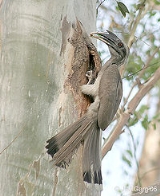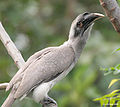
Indian Grey Hornbill
Encyclopedia
The Indian Grey Hornbill (Ocyceros birostris) is a common hornbill
found on the Indian subcontinent
. It is mostly arboreal and is commonly sighted in pairs. They have grey feather
s all over the body with a light grey or dull white belly. The horn is black or dark grey with a casque
extending up to the point of curvature in the horn. They are one of the few hornbill species found within urban areas in many cities where they are able to make use of large avenue trees.
 They are about 24 inches long. The upperparts are greyish brown and there is a slight trace of a pale supercilium. The ear coverts are darker. The flight feathers of the wing are dark brown and whitish tipped. The tail has a white tip and a dark subterminal band. They have a red iris and the eyelids have eyelashes. The casque is short and pointed. The male has a larger casque on a dark bill while the culmen and lower mandible are yellowish. The bare skin around the eye is dark in the male while it is sometimes pale reddish in females. The female has a more yellowish bill with black on the basal half and on the casque.
They are about 24 inches long. The upperparts are greyish brown and there is a slight trace of a pale supercilium. The ear coverts are darker. The flight feathers of the wing are dark brown and whitish tipped. The tail has a white tip and a dark subterminal band. They have a red iris and the eyelids have eyelashes. The casque is short and pointed. The male has a larger casque on a dark bill while the culmen and lower mandible are yellowish. The bare skin around the eye is dark in the male while it is sometimes pale reddish in females. The female has a more yellowish bill with black on the basal half and on the casque.
of the Western Ghats.
_in_hyderabad_w_img_8900.jpg) The call is a squealing call somewhat like that of a Black Kite
The call is a squealing call somewhat like that of a Black Kite
. The flight is heavy and involves flapping interspersed with glides. They are found in pairs or small groups.
The nesting season is April to June and the clutch varies from one to five very symmetrical white eggs. Indian Grey Hornbills usually nest in tree hollows on tall trees. An existing hollow may be excavated further to suit. The female enters the nest hollow and seals the nest hole and leaves only a small vertical slit that the male uses to feed her. The nest entrance is sealed by the female using its excreta and mud-pellets supplied by the male.
While inside the nest, the female moults her flight feathers and incubates the egg
s. The regrowth of the feathers in the female coincides with the maturity of the chicks at which point the nest is broken open.
A study at a nest near Mumbai noted that the key fruiting trees on which they fed were Streblus asper, Cansjera rheedii, Carissa carandas, Grewia tiliaefolia, Lannea coromandelica, Ficus spp., Sterculia urens and Securinega leucopyrus. They are also known to take molluscs, scorpions, insects, small birds (has been recorded removing and possibly preying on the chicks of Rose-ringed Parakeet
s) and reptiles in their diet They are known to feed on the fruits of Thevetia peruviana
which are known to be toxic to many vertebrates.
They are almost completely arboreal and very rarely descend to the ground where they may pick up fallen fruits or dust bathe. They descend to the ground also to pick up mud pellets for sealing the nest cavity during the nesting period. They indulge in various social activities which include bill-grappling and aerial jousting.
Hornbill
Hornbills are a family of bird found in tropical and subtropical Africa, Asia and Melanesia. They are characterized by a long, down-curved bill which is frequently brightly-colored and sometimes has a casque on the upper mandible. Both the common English and the scientific name of the family...
found on the Indian subcontinent
Indian subcontinent
The Indian subcontinent, also Indian Subcontinent, Indo-Pak Subcontinent or South Asian Subcontinent is a region of the Asian continent on the Indian tectonic plate from the Hindu Kush or Hindu Koh, Himalayas and including the Kuen Lun and Karakoram ranges, forming a land mass which extends...
. It is mostly arboreal and is commonly sighted in pairs. They have grey feather
Feather
Feathers are one of the epidermal growths that form the distinctive outer covering, or plumage, on birds and some non-avian theropod dinosaurs. They are considered the most complex integumentary structures found in vertebrates, and indeed a premier example of a complex evolutionary novelty. They...
s all over the body with a light grey or dull white belly. The horn is black or dark grey with a casque
Casque
Casque can refer to:* French word for helmet* An enlargement on the upper mandible of the bill of some species of birds, including many hornbills*Hornbill ivory: the casque of the Helmeted Hornbill, collected as a decorative material...
extending up to the point of curvature in the horn. They are one of the few hornbill species found within urban areas in many cities where they are able to make use of large avenue trees.
Description

Distribution
The species is found mainly on the plains up to about 2000 feet. It is found from the foothills of the Himalayas southwards bounded on the west by the Indus system and the Gangetic delta on the east. It may make local movements in the drier western region. It is found even within cities that have old avenue trees. It is found mainly on the plains up to about 1400 m and does not overlap much with the Malabar Grey HornbillMalabar Grey Hornbill
The Malabar Grey Hornbill, Ocyceros griseus, is a hornbill that is endemic to the Western Ghats and associated hills of southern India. They have a large beak but lack the casque that is prominent in other species of hornbills. They are found mainly in dense forest and around rubber, arecanut or...
of the Western Ghats.
Behaviour and ecology
_in_hyderabad_w_img_8900.jpg)
Black Kite
The Black Kite is a medium-sized bird of prey in the family Accipitridae, which also includes many other diurnal raptors. Unlike others of the group, they are opportunistic hunters and are more likely to scavenge. They spend a lot of time soaring and gliding in thermals in search of food. Their...
. The flight is heavy and involves flapping interspersed with glides. They are found in pairs or small groups.
The nesting season is April to June and the clutch varies from one to five very symmetrical white eggs. Indian Grey Hornbills usually nest in tree hollows on tall trees. An existing hollow may be excavated further to suit. The female enters the nest hollow and seals the nest hole and leaves only a small vertical slit that the male uses to feed her. The nest entrance is sealed by the female using its excreta and mud-pellets supplied by the male.
While inside the nest, the female moults her flight feathers and incubates the egg
Egg (biology)
An egg is an organic vessel in which an embryo first begins to develop. In most birds, reptiles, insects, molluscs, fish, and monotremes, an egg is the zygote, resulting from fertilization of the ovum, which is expelled from the body and permitted to develop outside the body until the developing...
s. The regrowth of the feathers in the female coincides with the maturity of the chicks at which point the nest is broken open.
A study at a nest near Mumbai noted that the key fruiting trees on which they fed were Streblus asper, Cansjera rheedii, Carissa carandas, Grewia tiliaefolia, Lannea coromandelica, Ficus spp., Sterculia urens and Securinega leucopyrus. They are also known to take molluscs, scorpions, insects, small birds (has been recorded removing and possibly preying on the chicks of Rose-ringed Parakeet
Rose-ringed Parakeet
The Rose-ringed Parakeet , also known as the Ringnecked Parakeet, is a gregarious tropical parakeet species that has an extremely large range. Since the trend of the population appears to be increasing, the species has been evaluated as Least Concern by IUCN in 2009.Rose-ringed parakeets are...
s) and reptiles in their diet They are known to feed on the fruits of Thevetia peruviana
Thevetia peruviana
Thevetia peruviana is a plant native to central and southern Mexico and Central America. It is a close relative of Nerium oleander, giving it one common name as Yellow Oleander, and is also called lucky nut in the West Indies....
which are known to be toxic to many vertebrates.
They are almost completely arboreal and very rarely descend to the ground where they may pick up fallen fruits or dust bathe. They descend to the ground also to pick up mud pellets for sealing the nest cavity during the nesting period. They indulge in various social activities which include bill-grappling and aerial jousting.

